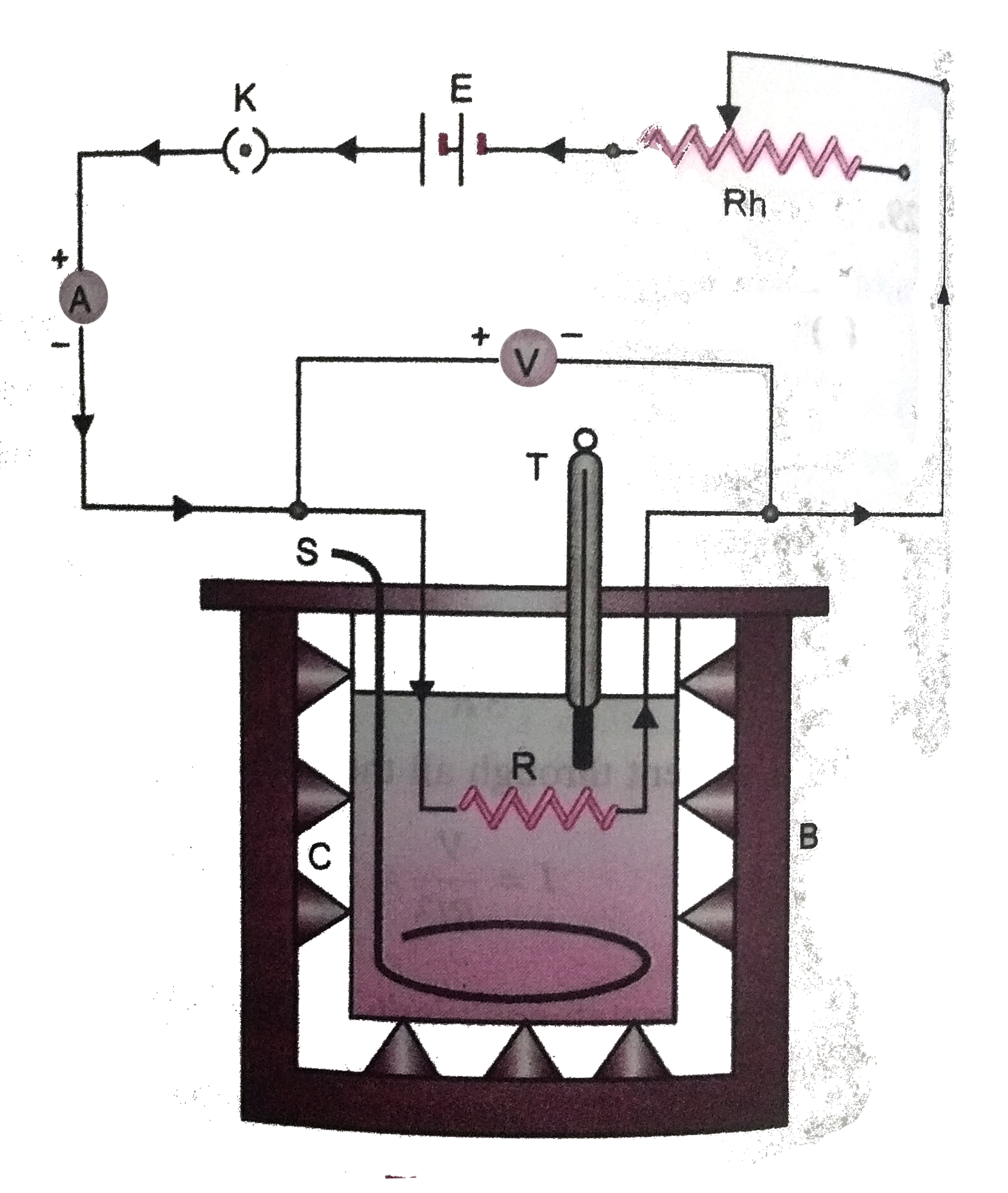What is Joule's heating effect ? How can it be demonstrated experimentally ? List its four applications in daily life.
Whenever a current flows through a wire, it gets heated. According or Joule's law, heat produced in a resistance wire when a current I flows through it for time t on applying a pd (V) across its ends, is given by
H=VIt4.2 cal
Experimental demonstration : Verification of Joule's law
Joule's law can be very easily verified with the help of the folowing experiment. This experiment is in fact the joule's electrical method of determining J (Joule's mechanical equivalent of heat).
Experiment arrangement. The calorimeter C along with its stirrer S is weighed. Water is filled in the calorimeter so that the resistance wire R completely dips in it. To avoid radiation losses, the colorimeter is placed in a wooden box B. With the help of a thermomter T, the initial temperature of water is noted. The circuit in closed by plugging in the key K. With the help of the rheostat Rh, a suitable current is passed through R for a known time. The ammeter A is used to measure the current through R and a voltmeter V is used to measure pd across its ends, (Fig. 3.47).
Current is passed for so long a time as to obtain a rise of about 5∘ to 7∘C in the water temperature. After stopping the current flow, water is throughly stirred and its temperature is noted.
Calculations.
Let I = curcuit (in ampere) through the resistance R
V = pd (in volt) across the ends of the resistance
t = time (in second) for which the current flows through the wire
w = water equivalent of the calorimeter with stirrer
m = mass of water in the calorimeter
θ1,θ2 = initial and final temperatures of water.
Heat gained by water =w(θ2−θ1) cal
Heat gained by calorimeter, stirrer and water =(w+m)(θ2−θ1) cal
Heat produced in the wire =VIt4.2 cal
It is found that within the limits of experimental error, (w+m)(θ2−θ1)=VIt4.2
Hence, Joule's Law is verified.
Applications in daily life. (i) Electric bulb, (ii) Electric oven, (iii) Electric geyser, (iv) Electric Iron.
 .
.
Topper's Solved these Questions
- BOOK - PRADEEPCHAPTER - ELECTRICITYEXERCISE - (Additional)Very Short Answer47videos
ELECTRICITY
- BOOK - PRADEEPCHAPTER - ELECTRICITYEXERCISE - (Additional)Short Answer36videos
ELECTRICITY
- BOOK - PRADEEPCHAPTER - ELECTRICITYEXERCISE - (Exemplar)Short Answer10videos
ELECTRICITY
- BOOK - PRADEEPCHAPTER - MAGNETIC EFFECTS OF ELECTRIC CURRENTEXERCISE - Mock Test21videos
MAGNETIC EFFECTS OF ELECTRIC CURRENT
Similar Questions
What is hill reaction ? How it can be demonstrated ?
View SolutionWhat do you mean by Kirchhoff's law? Discuss at least two applications of it in daily life.
View SolutionWhat is meant by Joule's heating effect due to flow of current through a conductor?
View SolutionWhat is a landslide? What are its effects on human life?
View SolutionWhat is water harvesting ? List its four benefits.
View SolutionWhat is heating effect of electric current? What is its origin?
View Solution(a) What is termed as 'breath of life' ?
(b) What is atmosphere ? List its four main concentric layers.
( c) Give three important aspects of atmospere.View Solution(a) What are transverse waves ? Give examples.
(b) How can it be demonstrated that sound waves are longitudinal ?View Solution(a) Derive the expression for the heat produced due to a current 'I' flowing for a time interval 't' through a resistor 'R' having a potential difference 'V' across its ends. With which name is this relation known?
(b) How much heat will an instrument of 12W produce in one minute if its is connected to a battery of 12V?
(c) The current passing through a room heater has been halved. what will happen to the heat produced by it?
(d) What is meant by the heating effect of current? Give two applications of the heating effect of current.
(e) Name the material which is used for making the filaments of an electric bulb.View SolutionDOPPLER EFFECT
View Solution

